University Business Registration Report: Advantages and Disadvantages
VerifiedAdded on 2022/09/11
|6
|966
|18
Report
AI Summary
This report provides a comprehensive overview of business registration in Ontario, focusing on the processes, fees, and different business structures available to entrepreneurs. It begins by outlining the business registration information provided by Service Ontario, including steps for registration, fees, and required forms for sole proprietorships and partnerships. The report then delves into a comparative analysis of three primary business structures: sole proprietorship, partnership, and corporation. It details the advantages and disadvantages of each structure, covering aspects such as ease of setup, capital raising, liability, and succession. The report references relevant sources to support its analysis, providing a well-rounded understanding of the subject matter and practical guidance for aspiring business owners in Ontario. The report also covers the business registration process including fees and forms required.
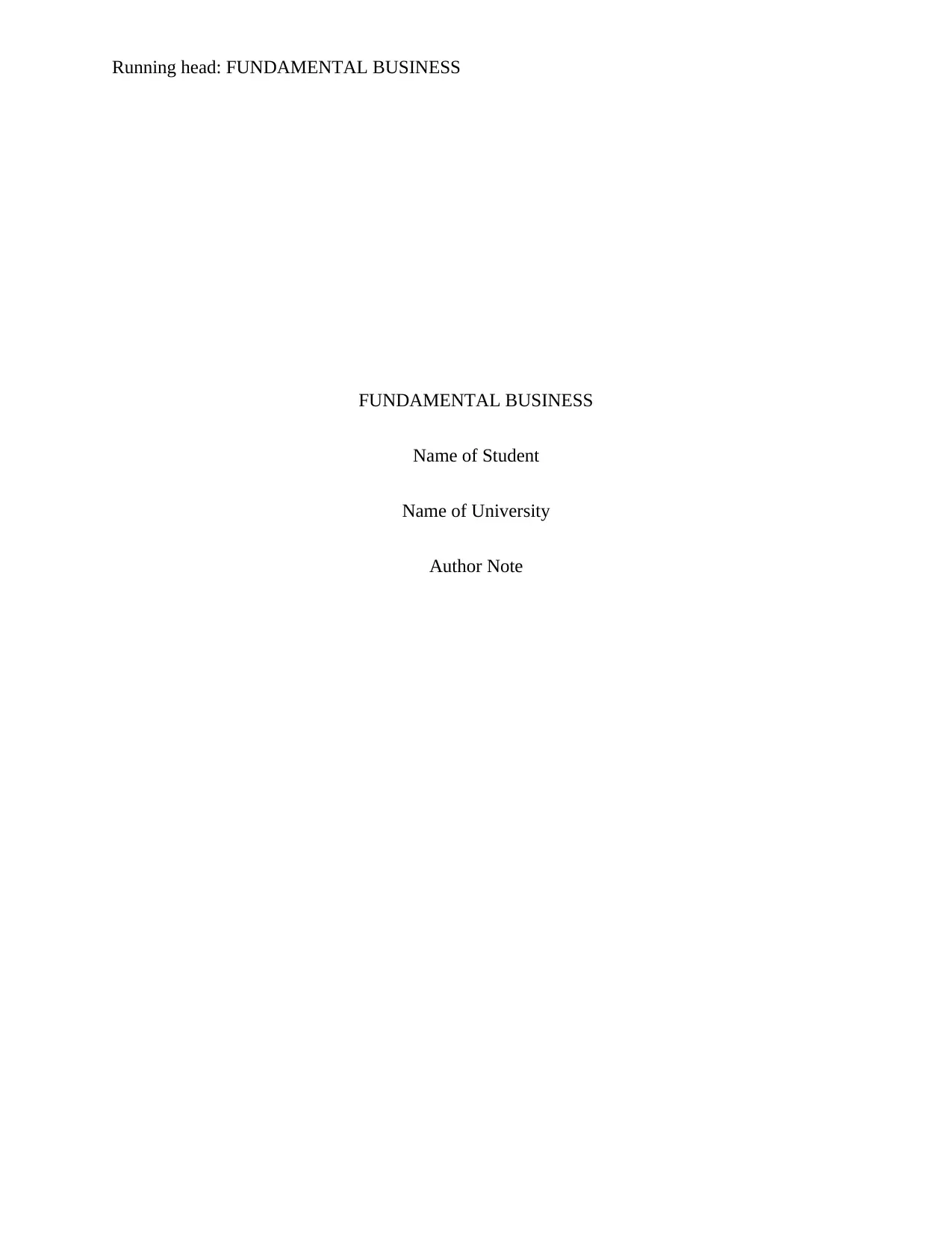
Running head: FUNDAMENTAL BUSINESS
FUNDAMENTAL BUSINESS
Name of Student
Name of University
Author Note
FUNDAMENTAL BUSINESS
Name of Student
Name of University
Author Note
Paraphrase This Document
Need a fresh take? Get an instant paraphrase of this document with our AI Paraphraser
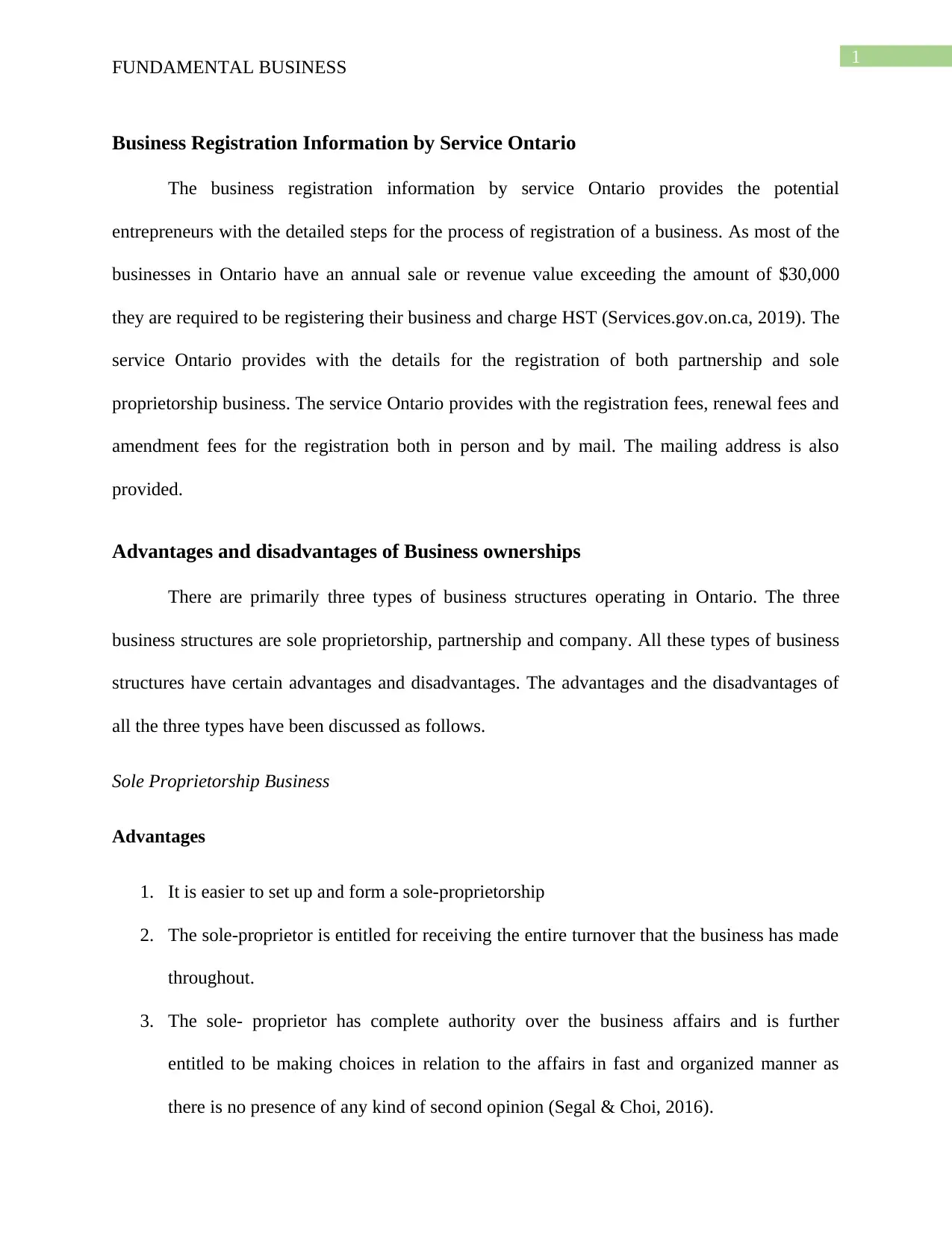
1
FUNDAMENTAL BUSINESS
Business Registration Information by Service Ontario
The business registration information by service Ontario provides the potential
entrepreneurs with the detailed steps for the process of registration of a business. As most of the
businesses in Ontario have an annual sale or revenue value exceeding the amount of $30,000
they are required to be registering their business and charge HST (Services.gov.on.ca, 2019). The
service Ontario provides with the details for the registration of both partnership and sole
proprietorship business. The service Ontario provides with the registration fees, renewal fees and
amendment fees for the registration both in person and by mail. The mailing address is also
provided.
Advantages and disadvantages of Business ownerships
There are primarily three types of business structures operating in Ontario. The three
business structures are sole proprietorship, partnership and company. All these types of business
structures have certain advantages and disadvantages. The advantages and the disadvantages of
all the three types have been discussed as follows.
Sole Proprietorship Business
Advantages
1. It is easier to set up and form a sole-proprietorship
2. The sole-proprietor is entitled for receiving the entire turnover that the business has made
throughout.
3. The sole- proprietor has complete authority over the business affairs and is further
entitled to be making choices in relation to the affairs in fast and organized manner as
there is no presence of any kind of second opinion (Segal & Choi, 2016).
FUNDAMENTAL BUSINESS
Business Registration Information by Service Ontario
The business registration information by service Ontario provides the potential
entrepreneurs with the detailed steps for the process of registration of a business. As most of the
businesses in Ontario have an annual sale or revenue value exceeding the amount of $30,000
they are required to be registering their business and charge HST (Services.gov.on.ca, 2019). The
service Ontario provides with the details for the registration of both partnership and sole
proprietorship business. The service Ontario provides with the registration fees, renewal fees and
amendment fees for the registration both in person and by mail. The mailing address is also
provided.
Advantages and disadvantages of Business ownerships
There are primarily three types of business structures operating in Ontario. The three
business structures are sole proprietorship, partnership and company. All these types of business
structures have certain advantages and disadvantages. The advantages and the disadvantages of
all the three types have been discussed as follows.
Sole Proprietorship Business
Advantages
1. It is easier to set up and form a sole-proprietorship
2. The sole-proprietor is entitled for receiving the entire turnover that the business has made
throughout.
3. The sole- proprietor has complete authority over the business affairs and is further
entitled to be making choices in relation to the affairs in fast and organized manner as
there is no presence of any kind of second opinion (Segal & Choi, 2016).
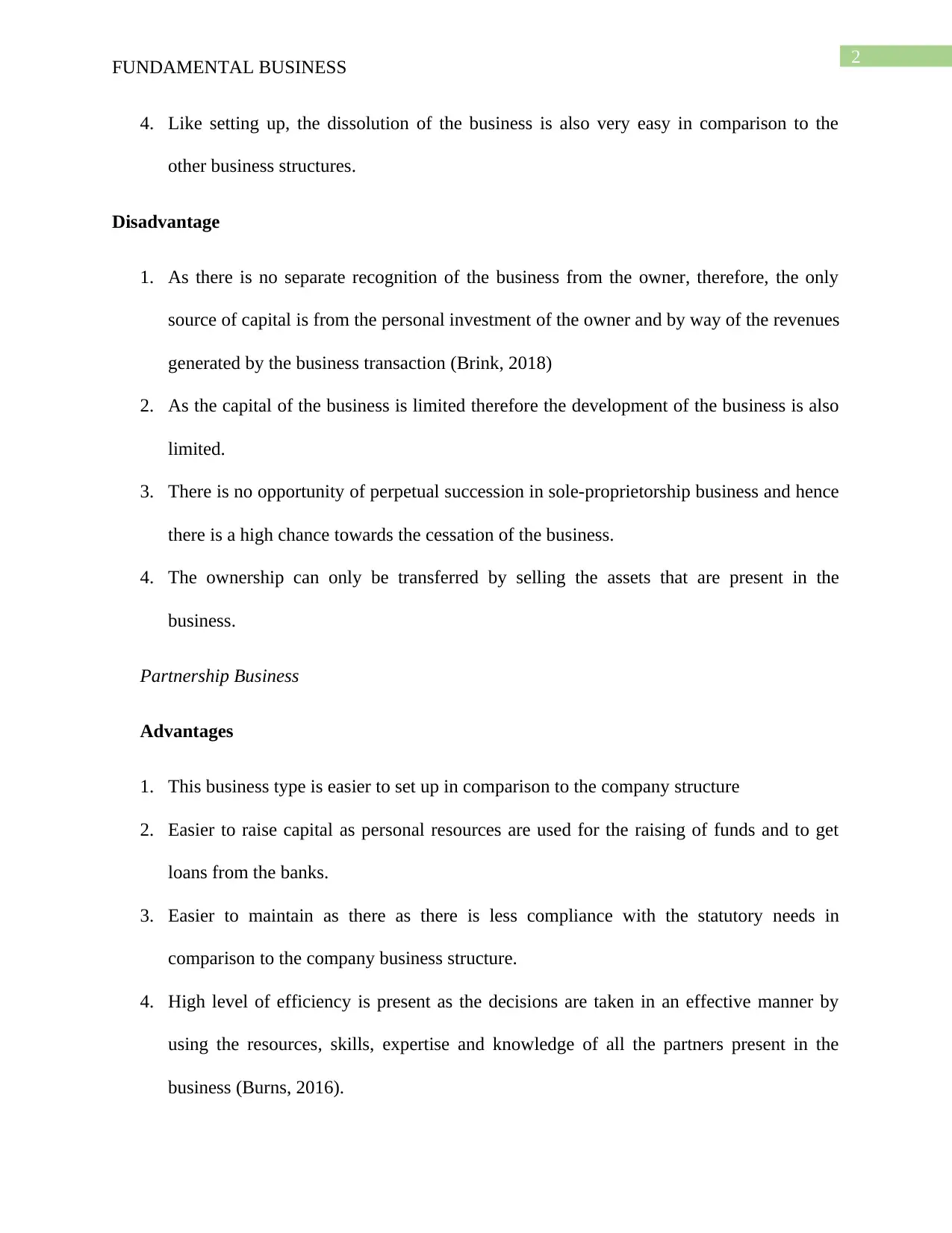
2
FUNDAMENTAL BUSINESS
4. Like setting up, the dissolution of the business is also very easy in comparison to the
other business structures.
Disadvantage
1. As there is no separate recognition of the business from the owner, therefore, the only
source of capital is from the personal investment of the owner and by way of the revenues
generated by the business transaction (Brink, 2018)
2. As the capital of the business is limited therefore the development of the business is also
limited.
3. There is no opportunity of perpetual succession in sole-proprietorship business and hence
there is a high chance towards the cessation of the business.
4. The ownership can only be transferred by selling the assets that are present in the
business.
Partnership Business
Advantages
1. This business type is easier to set up in comparison to the company structure
2. Easier to raise capital as personal resources are used for the raising of funds and to get
loans from the banks.
3. Easier to maintain as there as there is less compliance with the statutory needs in
comparison to the company business structure.
4. High level of efficiency is present as the decisions are taken in an effective manner by
using the resources, skills, expertise and knowledge of all the partners present in the
business (Burns, 2016).
FUNDAMENTAL BUSINESS
4. Like setting up, the dissolution of the business is also very easy in comparison to the
other business structures.
Disadvantage
1. As there is no separate recognition of the business from the owner, therefore, the only
source of capital is from the personal investment of the owner and by way of the revenues
generated by the business transaction (Brink, 2018)
2. As the capital of the business is limited therefore the development of the business is also
limited.
3. There is no opportunity of perpetual succession in sole-proprietorship business and hence
there is a high chance towards the cessation of the business.
4. The ownership can only be transferred by selling the assets that are present in the
business.
Partnership Business
Advantages
1. This business type is easier to set up in comparison to the company structure
2. Easier to raise capital as personal resources are used for the raising of funds and to get
loans from the banks.
3. Easier to maintain as there as there is less compliance with the statutory needs in
comparison to the company business structure.
4. High level of efficiency is present as the decisions are taken in an effective manner by
using the resources, skills, expertise and knowledge of all the partners present in the
business (Burns, 2016).
⊘ This is a preview!⊘
Do you want full access?
Subscribe today to unlock all pages.

Trusted by 1+ million students worldwide
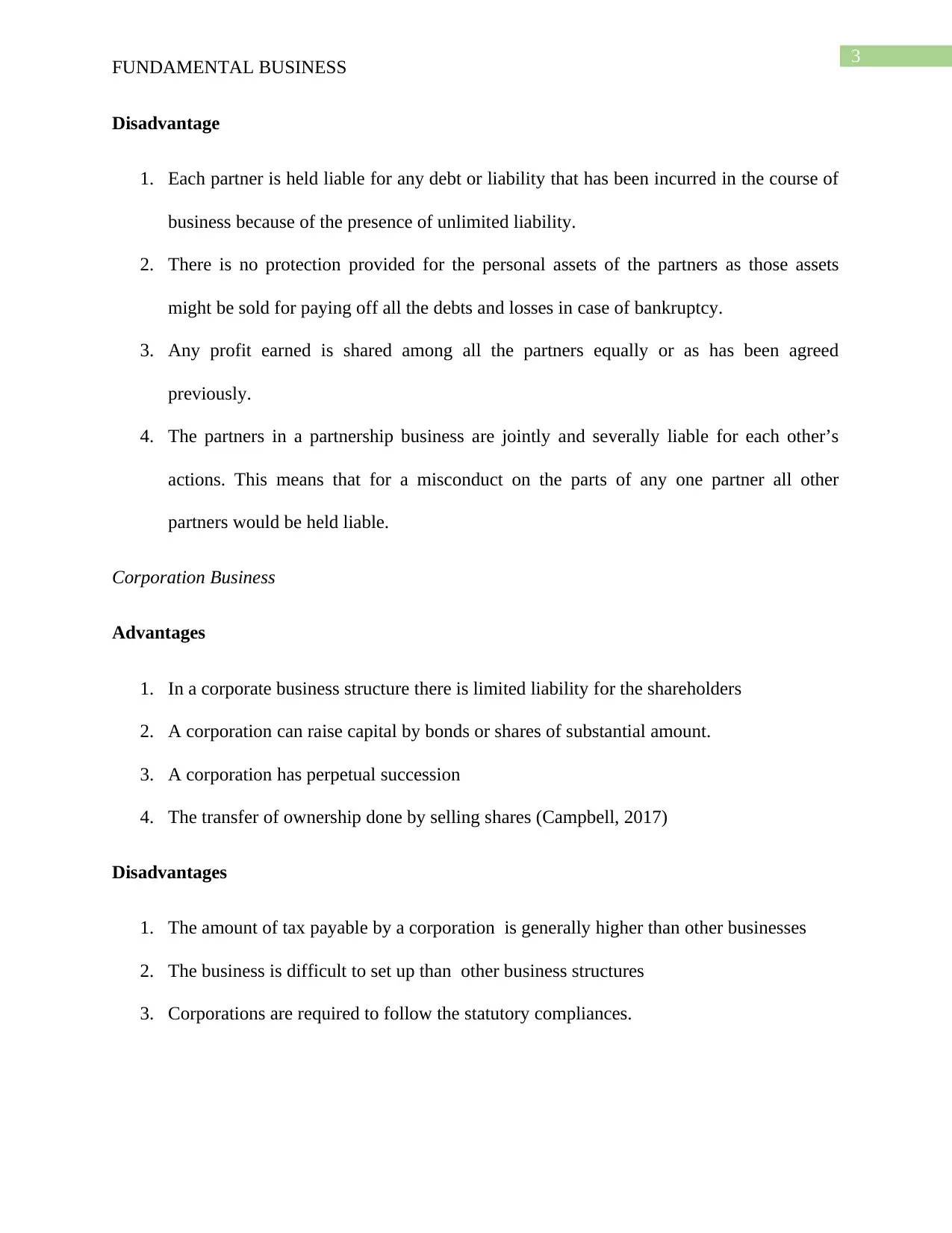
3
FUNDAMENTAL BUSINESS
Disadvantage
1. Each partner is held liable for any debt or liability that has been incurred in the course of
business because of the presence of unlimited liability.
2. There is no protection provided for the personal assets of the partners as those assets
might be sold for paying off all the debts and losses in case of bankruptcy.
3. Any profit earned is shared among all the partners equally or as has been agreed
previously.
4. The partners in a partnership business are jointly and severally liable for each other’s
actions. This means that for a misconduct on the parts of any one partner all other
partners would be held liable.
Corporation Business
Advantages
1. In a corporate business structure there is limited liability for the shareholders
2. A corporation can raise capital by bonds or shares of substantial amount.
3. A corporation has perpetual succession
4. The transfer of ownership done by selling shares (Campbell, 2017)
Disadvantages
1. The amount of tax payable by a corporation is generally higher than other businesses
2. The business is difficult to set up than other business structures
3. Corporations are required to follow the statutory compliances.
FUNDAMENTAL BUSINESS
Disadvantage
1. Each partner is held liable for any debt or liability that has been incurred in the course of
business because of the presence of unlimited liability.
2. There is no protection provided for the personal assets of the partners as those assets
might be sold for paying off all the debts and losses in case of bankruptcy.
3. Any profit earned is shared among all the partners equally or as has been agreed
previously.
4. The partners in a partnership business are jointly and severally liable for each other’s
actions. This means that for a misconduct on the parts of any one partner all other
partners would be held liable.
Corporation Business
Advantages
1. In a corporate business structure there is limited liability for the shareholders
2. A corporation can raise capital by bonds or shares of substantial amount.
3. A corporation has perpetual succession
4. The transfer of ownership done by selling shares (Campbell, 2017)
Disadvantages
1. The amount of tax payable by a corporation is generally higher than other businesses
2. The business is difficult to set up than other business structures
3. Corporations are required to follow the statutory compliances.
Paraphrase This Document
Need a fresh take? Get an instant paraphrase of this document with our AI Paraphraser
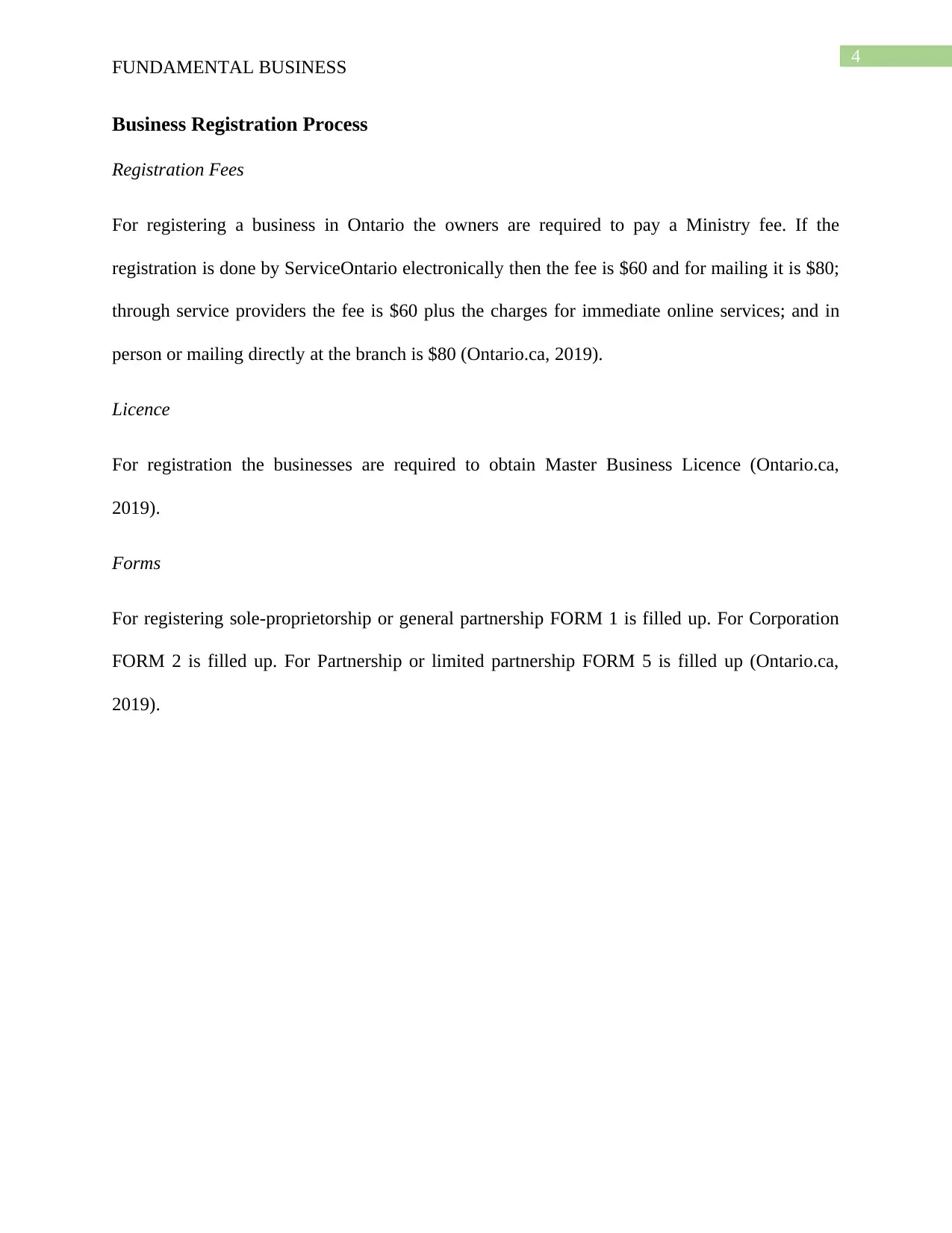
4
FUNDAMENTAL BUSINESS
Business Registration Process
Registration Fees
For registering a business in Ontario the owners are required to pay a Ministry fee. If the
registration is done by ServiceOntario electronically then the fee is $60 and for mailing it is $80;
through service providers the fee is $60 plus the charges for immediate online services; and in
person or mailing directly at the branch is $80 (Ontario.ca, 2019).
Licence
For registration the businesses are required to obtain Master Business Licence (Ontario.ca,
2019).
Forms
For registering sole-proprietorship or general partnership FORM 1 is filled up. For Corporation
FORM 2 is filled up. For Partnership or limited partnership FORM 5 is filled up (Ontario.ca,
2019).
FUNDAMENTAL BUSINESS
Business Registration Process
Registration Fees
For registering a business in Ontario the owners are required to pay a Ministry fee. If the
registration is done by ServiceOntario electronically then the fee is $60 and for mailing it is $80;
through service providers the fee is $60 plus the charges for immediate online services; and in
person or mailing directly at the branch is $80 (Ontario.ca, 2019).
Licence
For registration the businesses are required to obtain Master Business Licence (Ontario.ca,
2019).
Forms
For registering sole-proprietorship or general partnership FORM 1 is filled up. For Corporation
FORM 2 is filled up. For Partnership or limited partnership FORM 5 is filled up (Ontario.ca,
2019).
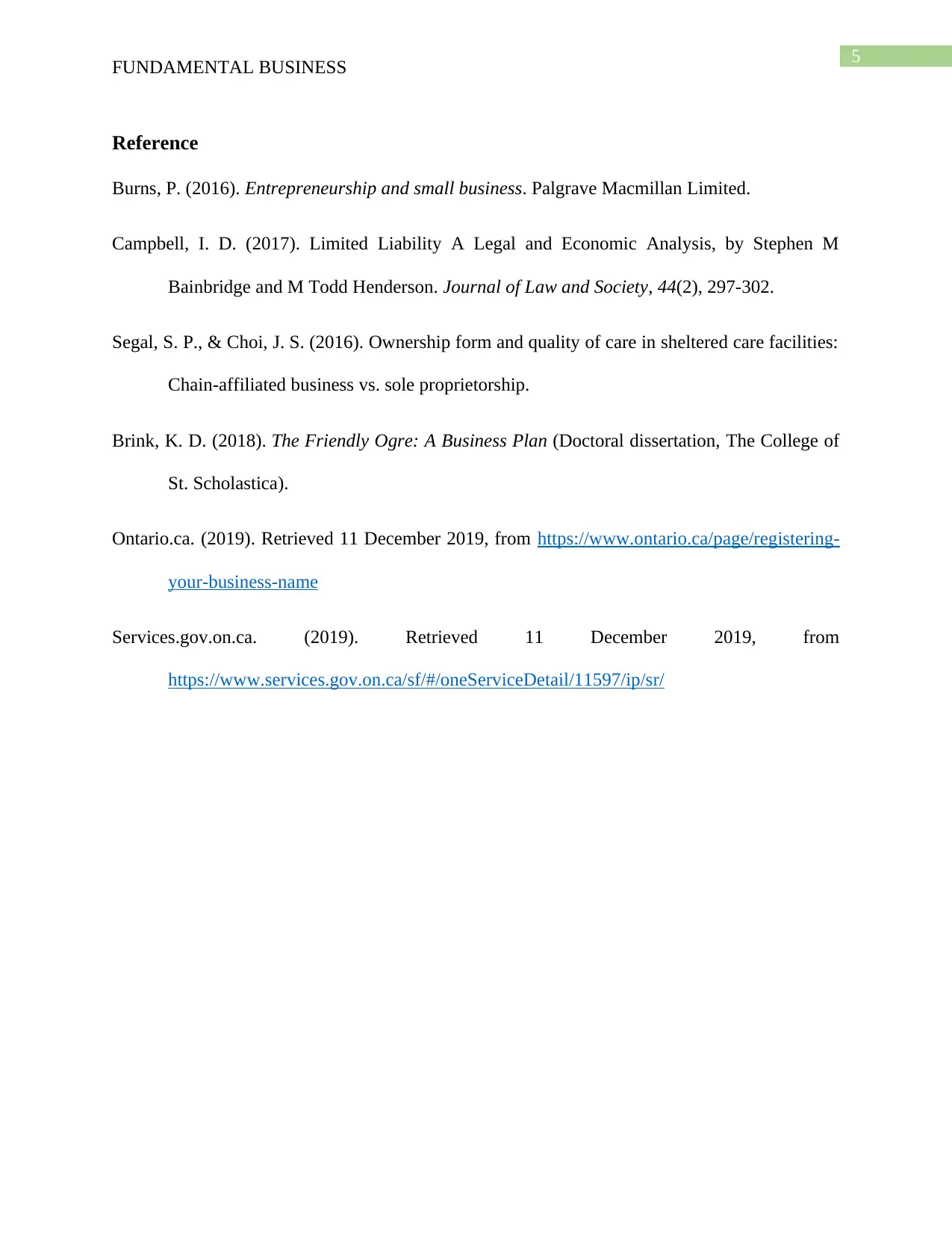
5
FUNDAMENTAL BUSINESS
Reference
Burns, P. (2016). Entrepreneurship and small business. Palgrave Macmillan Limited.
Campbell, I. D. (2017). Limited Liability A Legal and Economic Analysis, by Stephen M
Bainbridge and M Todd Henderson. Journal of Law and Society, 44(2), 297-302.
Segal, S. P., & Choi, J. S. (2016). Ownership form and quality of care in sheltered care facilities:
Chain-affiliated business vs. sole proprietorship.
Brink, K. D. (2018). The Friendly Ogre: A Business Plan (Doctoral dissertation, The College of
St. Scholastica).
Ontario.ca. (2019). Retrieved 11 December 2019, from https://www.ontario.ca/page/registering-
your-business-name
Services.gov.on.ca. (2019). Retrieved 11 December 2019, from
https://www.services.gov.on.ca/sf/#/oneServiceDetail/11597/ip/sr/
FUNDAMENTAL BUSINESS
Reference
Burns, P. (2016). Entrepreneurship and small business. Palgrave Macmillan Limited.
Campbell, I. D. (2017). Limited Liability A Legal and Economic Analysis, by Stephen M
Bainbridge and M Todd Henderson. Journal of Law and Society, 44(2), 297-302.
Segal, S. P., & Choi, J. S. (2016). Ownership form and quality of care in sheltered care facilities:
Chain-affiliated business vs. sole proprietorship.
Brink, K. D. (2018). The Friendly Ogre: A Business Plan (Doctoral dissertation, The College of
St. Scholastica).
Ontario.ca. (2019). Retrieved 11 December 2019, from https://www.ontario.ca/page/registering-
your-business-name
Services.gov.on.ca. (2019). Retrieved 11 December 2019, from
https://www.services.gov.on.ca/sf/#/oneServiceDetail/11597/ip/sr/
⊘ This is a preview!⊘
Do you want full access?
Subscribe today to unlock all pages.

Trusted by 1+ million students worldwide
1 out of 6
Related Documents
Your All-in-One AI-Powered Toolkit for Academic Success.
+13062052269
info@desklib.com
Available 24*7 on WhatsApp / Email
![[object Object]](/_next/static/media/star-bottom.7253800d.svg)
Unlock your academic potential
Copyright © 2020–2025 A2Z Services. All Rights Reserved. Developed and managed by ZUCOL.




